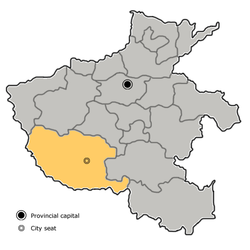Xinye County
This article needs additional citations for verification. (November 2006) |
Xinye County
新野县 Sinyeh | |
|---|---|
 Xinye in Nanyang | |
 Nanyang in Henan | |
| Coordinates: 32°31′15″N 112°21′36″E / 32.5209°N 112.3601°ECoordinates: 32°31′15″N 112°21′36″E / 32.5209°N 112.3601°E | |
| Country | People's Republic of China |
| Province | Henan |
| Prefecture-level city | Nanyang |
| Area | |
| • Total | 1,056 km2 (408 sq mi) |
| Population (2019)[2] | |
| • Total | 633,600 |
| • Density | 600/km2 (1,600/sq mi) |
| Time zone | UTC+8 (China Standard) |
| Postal code | 473500 |
Xinye (Chinese: 新野; pinyin: Xīnyě; Wade–Giles: Hsin-yeh) is one of the counties of Nanyang[3] that lies in the southwest of Henan province, China. To the south lies the prefecture-level city of Xiangyang in Hubei province, to the east is Tanghe County and to the west is the county-level city of Dengzhou. Xinye county has a population of 730,000[when?]. Its total area is 1,062 km2 (410 sq mi).
The G55 Erenhot–Guangzhou Expressway runs through Waizi town, which is the northmost town of Xinye. Both Nanyang Jiangying Airport and Xiangyang Liuji Airport are about 60 km (37 mi) away from Xinye.

History[]
This section needs expansion. You can help by . (August 2012) |
Near the end of the Han Dynasty, the warlord Liu Bei used Xinye as a base, as a vassal under Liu Biao. Liu Biao himself had been residing in Xiangyang (today's Xiangfan). Liu Bei lost Xinye to Cao Cao in 208 and retreated to the southeast in prelude to the battle of the Red Cliffs.[4]
Administrative divisions[]
As 2012, this county is divided to 2 subdistricts, 8 towns and 5 townships.[5]
- Subdistricts
- Hanhua Subdistrict (汉华街道)
- (汉城街道)
- Towns
|
|
- Townships
|
|
References[]
- ^ 最新人口信息 www.hongheiku.com (in Chinese). hongheiku. Retrieved 2021-01-12.
- ^ 最新人口信息 www.hongheiku.com (in Chinese). hongheiku. Retrieved 2021-01-12.
- ^ Bernstein, Thomas P.; Xiaobo Lü (2003). Taxation without Representation in Contemporary Rural China. Cambridge University Press. p. 157. ISBN 9781139438049.
- ^ Liangyan Ge (2015). The Scholar and the State: Fiction as Political Discourse in Late Imperial China. pp. 44–45. ISBN 9780295805610.
- ^ 安阳市-行政区划网 www.xzqh.org (in Chinese). XZQH. Retrieved 2012-05-24.
- Xinye County
- County-level divisions of Henan
- Nanyang, Henan
- Henan geography stubs
